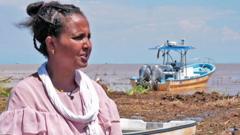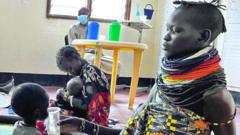Senait Mebrehtu lost her 14-year-old daughter Hiyab during a perilous crossing over Lake Turkana, highlighting the escalating crisis of migrant smuggling in East Africa. Smugglers exploit desperate families, often leading to deadly tragedies on unseaworthy boats.
Tragedy on Lake Turkana: A Mother's Grief Amidst Migrant Smuggling Crisis

Tragedy on Lake Turkana: A Mother's Grief Amidst Migrant Smuggling Crisis
A mother mourns her daughter's death while shedding light on the dangerous routes used by smugglers to transport migrants from Eritrea to Kenya.
As the sun dipped below the horizon of Lake Turkana, Senait Mebrehtu stood on the shore, overwhelmed with grief as she tossed flowers into the water in memory of her daughter, Hiyab, who drowned while attempting to migrate to Kenya. The poignant moment transported her back to a year ago when she lost her 14-year-old daughter, who was traveling with her older sister on a treacherous journey facilitated by smugglers. The teenage girl’s sister fortunately survived the harrowing late-night boat crossing over the unpredictable lake’s waters.
Senait, having fled Eritrea for Kenya three years earlier due to religious persecution, had hoped her daughters could join her but was unable to transport them herself. Seeking a better life, Hiyab and her sister sought the assistance of smugglers who promised them safe passage. What they encountered instead was a perilous route that led them through northern Ethiopia and finally to the lake's shores.
A female smuggler operating in Kenya described Lake Turkana as the "digital route," a newer method utilized for illegal crossings as patrols on land increase. Smugglers earn around $1,500 for each migrant they transport—substantially higher than the average Kenyan salary. They are now rerouting many migrants via the expansive waters of Lake Turkana, a beautiful but dangerous environment transforming into a path fraught with risk.
Senait, blaming the smugglers for the accident, recounted how Hiyab's overloaded boat capsized after leaving Ileret, resulting in seven fatalities. Reports from fishermen show that drowning victims, presumed to be migrants, are increasingly discovered afloat in the lake, underlining the dangers of such journeys.
The UN reports that around 345,000 Eritrean refugees and asylum seekers are currently in East Africa, drawn by conflict and instability in neighboring regions. Conversations with Eritrean advocates reveal that Kenya and Uganda are becoming preferred destinations as conditions deteriorate further in Ethiopia and Sudan.
Those who manage to cross into Kenya often find themselves caught in a smuggling web that stretches through East Africa, and many—including women—face horrific conditions. Smugglers maintain "holding houses," where migrants may wait for additional transportation, often disappearing into the darkness without a trace.
While Senait finds little solace in her elder daughter's safety, she emphasizes the urgency for intervention and awareness to prevent additional tragedies. "May God heal our land and deliver us from all this," she utters, a heartfelt plea resonating through the continuing plight of many Eritreans.





















